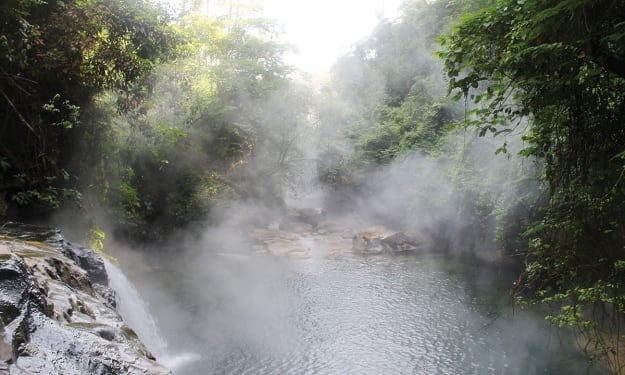The Door to Hell: Exploring the Origins and Impact of the Darwaza Gas Crater
The Science Behind the Eternal Flame: Methane Ignition Explained

The Darwaza gas caldera, situated in the Karakum desert of Central Asia, is frequently referred to as the entrance to purgatory by individuals. It was established in 1971 by Soviet geologists to simplify hydrocarbon extraction operations. Nevertheless, they inadvertently ignited methane in an underground crevice that was brimming with natural gas. Subsequently, the ground collapsed, rendering it incapable of sustaining the apparatus's weight. Since that time, the crater has been erupting continuously, with temperatures that have reached as high as 1,000 degrees Celsius. The crater is 65 feet deep and 230 feet wide.
The initial decision was to detonate the methane in order to prevent the escape of natural gas into the atmosphere, which could have had severe environmental and health consequences. Methane is a gas that is both extremely flammable and hazardous, as a mere five percent of it in the atmosphere is required to trigger a reaction. However, the geologists' actions led to some unintended consequences and misconceptions. They erroneously believed that the local fauna was being decimated by the inability to breathe. Additionally, the gas displaced oxygen, which caused the geologists to incorrectly conclude that the local fauna was in danger of extinction.
The arachnid were captivated by the flame, which caused them to plunge into the fire pit, thereby further enhancing the eerie atmosphere. The Soviet crew initially believed that igniting the crater would resolve the issue; however, the gas continues to ignite to this day, 50 years later. The crater has witnessed a remarkable transformation from a site of hazardous accidents to a captivating tourist destination over time. The crater's fiery display has now become a popular destination for visitors from around the globe, who can safely observe the spectacle without causing any damage to their eyebrows.
In 2015, a scientist named George Kourounis penetrated the crater to collect sediment samples. Rob facilitated this daring endeavor by designing a distinctive suit to protect Kourounis from the severe conditions. The suit's efficacy was demonstrated during this expedition when it enabled Kourounis to conduct soil research at temperatures that could dissolve flesh. Even the National Geographic Channel produced a documentary about his exploits, emphasizing the scientific importance of such extreme investigations.
The descent serves a substantial purpose, despite the absurdity of enduring volcanic temperatures for soil samples. Insights into the potential for life to flourish in environments that were previously considered uninhabitable can be gained by studying soil under such severe conditions. This research has the potential to significantly impact our comprehension of life on Earth and potentially on other planets. Soil research provides valuable data for astrobiology and extreme ecology, offering a view into the potential adaptations and survival strategies of life in high-temperature environments in these extreme circumstances.
The Darwaza crater serves as evidence that human activity has the capacity to unintentionally produce significant and enduring phenomena. Similar to the eternal fire of Centralia, Pennsylvania, and the Kola Superdeep Borehole in Russia, the Darwaza caldera serves as a reminder of the complex relationship between human endeavors and the natural world. While these sites may not always be pleasurable to be in close proximity, they offer unique opportunities for scientific research and public interest.
Despite its origins as an industrial accident, the Darwaza gas crater now serves as a potent illustration of how unanticipated events can lead to significant discoveries. In the future, we may be able to employ the crater's perpetual smoldering, which is frequently referred to as the largest marshmallow roast in history, to offer practical solutions. Currently, it remains an extraordinary natural phenomenon that captivates both scientists and visitors.
When visitors have the opportunity to witness the crater in person, they are frequently astounded by its abysmal magnificence. The smoldering pit's appearance against the Karakum desert's backdrop is both meek and awe-inspiring. Some individuals even take advantage of the intense heat of the crater by engaging in frivolous activities, such as toasting marshmallows or hot dogs on a stick.
In conclusion, the Darwaza gas crater is a captivating example of the potential for human actions to unintentionally produce natural wonders. Its enduring flames function as both a cautionary tale and a source of scientific inquiry. The Darwaza crater will unquestionably remain a significant landmark in the study of extreme environments and the potential for life in harsh conditions as research continues and more revelations about this fiery anomaly emerge.
About the Creator
Enjoyed the story? Support the Creator.
Subscribe for free to receive all their stories in your feed. You could also pledge your support or give them a one-off tip, letting them know you appreciate their work.





Comments
There are no comments for this story
Be the first to respond and start the conversation.